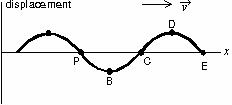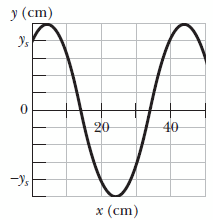A traveling sinusoidal wave is shown below. At which point is the motion 180° out of phase with the motion at point P?
At the time of the picutre, point P is at phase π/2=90° and poitn C is at phase 3π/2=270°. To see this, think of a cosine curve with the phase=0 point being the first unlabeled dot (it is supposed to be labeled "A").
So, C is 180° out of phase with P right now, but what about its "motion"? As the wave moves to the right, P will move up while C will move down... so that's good.
But more generally, the phase of any point is (kx−ωt+φ) , that is, the argument of the cosine in the equation for the wave. As time advances, the −ωt term changes the phase of every x point by the same amount. So the phase difference between two points at one time will be the same phase difference for all time.
A sinusoidal transverse wave is traveling along a string in the negative direction of an x axis. The figure below shows a plot of the displacement as a function of position at time t = 0. The x axis is marked in increments of 10 cm and the y axis is marked in increments of 1 cm. The string tension is 4.5 N, and its linear density is 30 g/m.

(a) Find the amplitude.
(b) Find the wavelength.
This is the length of one cycle. From the displacement vs. position graph it can be read directly. For instance, phase = 0 happens at x = 4cm and phase = 2π happens at x = 43cm, so a length of 39cm contains one cycle.
(c) Find the wave speed.
It is impossible to find wave speed from a graph. But the question statement gives the tension and linear mass density, from which the wave speed can be calculates: v = sqrt(τ/μ) = sqrt(4.5N/(0.03kg/m)) = 12.25m/s
(d) Find the period of the wave.
This is the time for one cycle. It is impossible to find this from a graph of displacement vs. position, which contains no time information. But we can use the equation v = λ/T with the previous two answers, to get T = λ/v = 0.0318s .
(e) Find the maximum speed of a particle in the string.
(f) Complete the equation describing the traveling wave, in which x and y are in meters, angle in radians, and t is in seconds. y(x, t) = [] sin( [] x + [] t + [] )